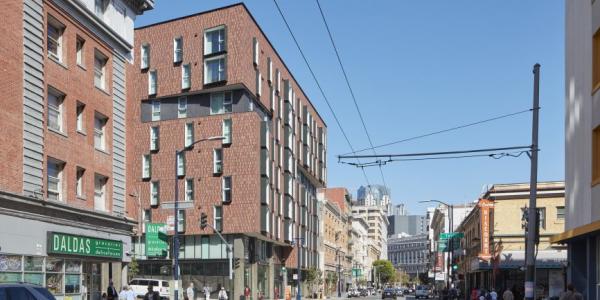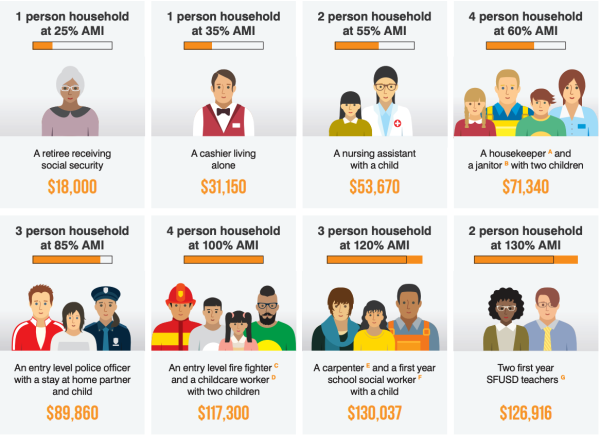

This November, San Francisco voters will be asked to choose between two competing charter amendments to streamline the creation of new affordable and workforce housing: Prop. D and Prop. E. On the face of it, the two ballot measures appear very similar. But the policy details included in these measures make a significant difference in the impact each would have on affordable housing production in San Francisco.
Prop. D, Affordable Homes Now, is a voter initiative sponsored by SPUR and a coalition of nonprofit groups including Habitat for Humanity Greater Bay Area, Nor Cal Carpenters Union, Mission Housing, GrowSF, Greenbelt Alliance, Housing Action Coalition and YIMBY Action. Prop. D would streamline the approvals process for three different types of projects: 100% affordable housing, mixed-income housing projects with increased affordability, and educator housing. Affordable Homes Now has the support of Mayor London Breed, Supervisor Matt Dorsey and Senator Scott Wiener.
Supervisor Connie Chan introduced a competing charter amendment, Prop. E, the Affordable Housing Production Act. Although Prop. E would also remove some red tape for the approvals of selected types of housing development, it does not fully streamline 100% affordable housing projects, it places additional requirements on mixed-income projects and it has more restrictive labor standards than Affordable Homes Now. Prop. E has been co-sponsored by Supervisors Peskin, Walton, Mar, Ronen, Preston and Safai.
Here’s a summary of the key differences between Prop. D and Prop. E:
1. Prop. D fully streamlines 100% affordable projects.
Under Prop. D, permitting and funding for projects where 100% of the units are affordable to low- and middle-income households would no longer be discretionary. This means proposed projects that conform to existing zoning rules would not be required to undergo additional environmental review under the California Environmental Quality Act (CEQA), and they would be protected from lawsuits under the same law. Prop. E does not remove funding decisions from discretionary review, which means that 100% affordable housing projects seeking city funds would be subject to CEQA review and vulnerable to potential lawsuits. It’s important to note that while CEQA was originally intended to protect the environment from the negative impacts of sprawl, NIMBY groups often use this law to block much-needed housing development in cities. Prop. E would do nothing to stop this abuse of CEQA.
The two charter amendments also differ on what levels of affordability they target. Under existing state law SB 35, low-income housing projects that serve households with incomes below 80% of the area median income (AMI) are already fully streamlined and exempt from CEQA. Prop. D would expand the streamlining to include moderate and middle-income households. A 100% affordable project that provides an average affordability level of 120% of the Area Median Income (AMI) would be eligible for streamlining, compared to 80% AMI Income under state law. Under Prop. D, this would allow 100% affordable housing projects to also include some middle-income units for households making up to 140% of AMI. To ensure that the prices and rents are not set higher than the neighborhood average, the homes would have to be priced 20% below the average for the neighborhood.
Figure 1. What Does AMI Mean? Examples of Affordable Housing Levels in 2020

Encouraging more moderate and middle-income housing is consistent with the city’s existing policy commitment under 2019’s Prop E, which made it easier to build housing for educators earning up to 140% of AMI. Recognizing the need for more affordable housing opportunities for moderate and middle-class families who don’t qualify for existing programs and subsidies, many community groups have sought city support for developing these types of units. For example, MEDA has proposed a new condominium project at 2205 Mission Street that would provide new condominiums affordable to households with incomes between 80% and 130% of AMI.
Prop. E requires that 100% affordable housing projects have a much lower overall average affordability of 80% of AMI to be eligible for streamlining. In this way, Prop. E simply replicates existing state law without the benefit of a CEQA exemption, making it ineffective for encouraging the development of new 100% affordable housing projects. Prop. E would also exclude the possibility of expediting 100% affordable projects that are intended to serve first-time homeowners and moderate income families.
2. Prop. E imposes more onerous requirements for mixed-income projects.
Prop. D requires that streamlined mixed-income projects provide 15% more affordable units than currently required by the city’s existing inclusionary policy. Today, 22% of units in new rental housing projects must be affordable to low- and moderate-income households. Under Prop. D, a 100-unit rental project would require a total of 25 units (22 units + 3 additional units [15% of 22] = 25 units). The additional affordable units would have the same maximum sales prices and rent tiers as those established in the city’s inclusionary policy.
Prop. E requires that mixed-income projects have an increased inclusionary rate of 8% above the existing rate, meaning that the inclusionary requirement for rental housing would be 30%. For a 100-unit rental project, a total of 30 units would be required. The city’s Housing Affordability Strategies and other studies have repeatedly demonstrated that the existing inclusionary rate is already challenging for many mixed-income projects. Increasing it to 30% will render most mixed-income projects in San Francisco infeasible, which means that Prop. E is not likely to increase the production of affordable housing.
Figure 2. Comparison of Affordable Units Required in Mixed-Income Housing Projects
Existing Inclusionary Policy
Prop. D (SPUR-sponsored)